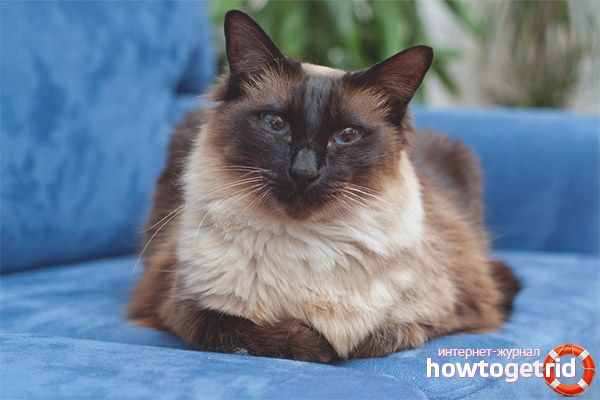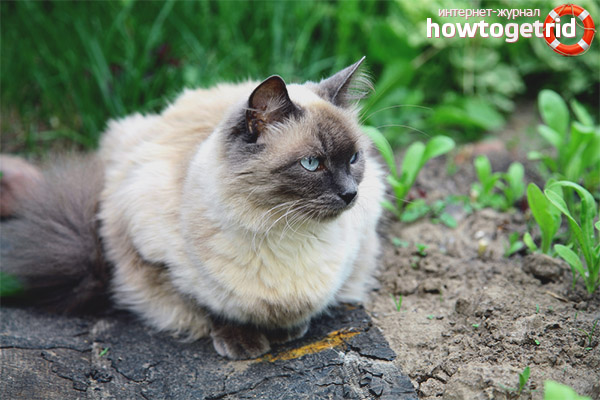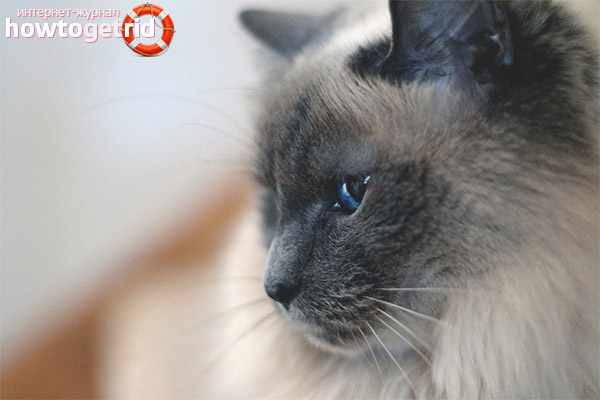The content of the article
Balinese cat is one of the most charming, affectionate and smart breeds. Most people who decide to have such a beautiful pet in their home will not be able to briefly describe its attractiveness and affection, as this pet confirms its brilliant reputation.
Historical reference
The name of the breed is of English origin Balinese cat, and in addition to the main name, it is called a Balinese cat. It has international names. For example, in Australia she is called Oriental Longhair, in France - Balinais, in Germany - Balinesen, and her obsolete name is Long haired Siamese.
Balinese have an aristocratic gait and posture, slender, with a fixed look, they hide under a royal and proud appearance a loving and tender heart. They also differ in their level of intelligence, because the owners will immediately be able to appreciate their originality and curiosity.
The origin of the Balinese breed comes from Siamese cats. The exact reason for the appearance of such a breed in the world is still unknown, but there is a version that Balinese is the result of a combination of Angora and Siamese cats, although, unlike the latter, they have a long coat. Despite this, Balinese does not require special care due to the lack of undercoat, as, for example, in Maine Coons and any other cat breeds.
It is common for Balineses to become attached only to their owner or a certain family member, however, they themselves are very friendly and easily come into contact with other pets, if any. Balinese cats are always affectionate and sociable, like to spend time in the company of people and can become the best friend of the whole family. They get along well with children, so all the fears of adults for the welfare of their kids will be in vain. They have a loud voice, but soft and musical compared to Siamese cats, although they have a lot of similarities with them.
The exact appearance of such a breed is still unknown, but there are two hypotheses of their occurrence: balines appeared as a result of crossing Angora and Siamese cats, or the cause could be a natural mutation.
Given the fact that Helen was an unusual person, a medium and a mystic, the name of the breed was not without reason original. She called them Balinese, for their graceful movements, reminiscent of dancers from the island of Bali, which, incidentally, is located near Siam (now Thailand), which is a kind of reference to the history of the breed.
The idea of breeding a new breed first received numerous negative reviews primarily from Siamese cat breeders. Those believed that the new breed would have a negative impact on the Siamese genetics and lower demand, but by 1970, thanks to the persistence of the breeders, the Balinese were still recognized by American cat lovers associations. 10 years before this breed was recognized in America, and in the mid-eighties in Europe. So, by the number of registered breeds recognized in the USA, in 2012, the Balinese breed ranked 28 out of 42.
Description
- A distinctive feature of these cats is a long elongated body of a tube-shaped shape, and strength and muscularity emphasize the grace of the whole body.
- Paws are long and thin, movements are sophisticated and refined. The cat has an aristocratic, graceful and proud appearance, which confirms its name.
- The weight of mature cats is from 3.5 to 4.5 kg, cats can weigh from 2.5 to 3.5 kg. Live on average from 12 to 15 years.
- The head is of medium size and has the shape of a tapering wedge, the muzzle is wedge-shaped, has a smooth forehead, and the ears are wide apart.
- The color of the eyes of cats is blue, almost sapphire. The shape is almond-shaped, also widely spaced, and the width between the eyes should be a few centimeters.
- Unlike the Siamese, they have a very soft and gentle voice, somewhat musical. For lovers of quiet and calm pets, the Balinese breed is best suited, and listening to soft and soft purrs during the day is a pleasure.
- They have a smooth, silky and soft coat with no undercoat that fits snugly to the body. So, the length of the wool itself is visually reduced, although on average it can vary from 1.5 to 5 cm. This length makes the coat more round and soft. Fluffy and long tail forms a plume.
- The tail itself is long and smooth, without any prominent defects (creases, bumps).
The plume is evidence that the cat is actually a Balinese breed. It is not difficult to comb out the cat’s hair, the process will turn into a pleasant game, since they don’t have undercoat.
Color
Color is a uniformly distributed spots on the legs, tail and eyes, on the face form a mask - color point. The rest of the body is light in color. Real balines have a uniform color without bright spots.
Initially, the list of color points was not very large. Only 4 colors were allowed: seal poin (sial) t, lilac point (lilac), chocolate point (chocolate), blue point (blue). But after the unification of Balinese and Javanese cats took place in early May in 2008, the list was replenished with new shades, such as red point, cream point, cinnamon point and others.
Due to acromelanism, spots on parts of the body of cats are darker than the color of the rest of the coat. This means that due to the genetic type of pigmentation, such colors may appear depending on the temperature in some parts of the body and the rest. The colder this or that part in comparison with the others, a pronounced color appears in that area. The older the cat becomes, the darker the body color becomes.
Character
Balinese cats have a wonderful character. They are attached to the family and the owner, love to be in the company of close people, the best friend of the family and children, who will always be there, regardless of whether the family member works, engages in important activities or just relaxes, and at the same time does not interfere with the process of what you love.
Balinese people like to chat and spend time in someone else’s company from the family, they don’t like to be alone for a long time without attention, so from time to time they can be entertained by the game. Cats can turn into a toy any object that is unnecessary or abandoned by one of the family members. This factor is another plus in friendship with pets of this breed, since they do not require a lot of costs.
Cats can also have a good time playing with children; they get along well not only with adults. It is worth considering the well-developed intelligence of the Balinese, due to which they can easily get used to the noise and activity of children, sometimes even themselves take part in such fun. Small children can be careless and follow the cat on its heels, chasing it, which Balinese does not like very much and can resist the enemy. On the other hand, a cat can become an excellent companion for those children who are neat with it.
Allergy
In comparison with other breeds, Balinese people have a significant difference in the production of allergens Fel d 1, which is found in cats' saliva and Fel d 4, which is found in urine, therefore allergies are less likely for those wishing to have such a pet than in the case of other breeds. There is no scientific evidence for this factor, however, studies are still being conducted in the United States to establish exact criteria for the occurrence of allergic reactions in the human body, or to prove that cats are indeed hypoallergenic.
Maintenance and care
Cats have no undercoat, due to which the hair is not going to lump, and combing soft and silky hair will be very easy. It is recommended to carry out such a procedure once or twice a week to remove dead hairs from the surface of the coat and skin of the pet.
It is advisable to brush your pet’s teeth daily, but this can cause some difficulties, so brushing your teeth once a week is the best option. Using cotton swabs, you also need to clean your ears balinese once a week. Be sure to monitor the condition of the eyes. If it is required to remove mote or other particles from the mucous membrane, it is necessary to remove them only with clean cotton swabs, without reuse. A separate clean swab should be provided for each eye and ear. You should always maintain cleanliness in the house and monitor the hygiene of the pet, which should not be difficult, since this breed does not require special care for care.
Cats do not scratch the furniture, but if you wish, you can train your pet in a claw-tip yourself. It happens that in a good nursery at an early age they are accustomed to a clawbrush and toilet. Only after training and the start of growing up, cats can be put up for sale.
Health
The Balinese breed is considered one of the healthiest, although due to the fact that it is genetically different from the Siamese breed only by the length of the coat, it inherited some diseases that can occur if the simple hygiene rules are not followed and if proper care is not taken in general. With good care, cats can live more than 15 years.
Amyloidosis is one of the diseases that can result in a fatal outcome for a pet. The essence of this disease is a violation of protein metabolism, as a result of which an amyloid protein-polysaccharide complex is formed in the tissues. Such an ailment contributes to the formation of amyloid in the liver, its defeat and death.
The gastrointestinal tract, adrenal glands, spleen, pancreas can also suffer. Using the example of Siamese people between 1 and 4 years old who suffered from liver disease, symptoms such as excessive thirst, jaundice, loss of appetite, and depression were revealed. There is still no cure for such a disease, but its progression can be slowed if symptoms are identified as early as possible.
Strabismus has become possible to deduce, which is what they do in many nurseries, but cats can make themselves felt throughout their lives. The gene responsible for this disease intersects with the genes that are responsible for point color, so it cannot be destroyed.
Video: Balinese cat













Submit